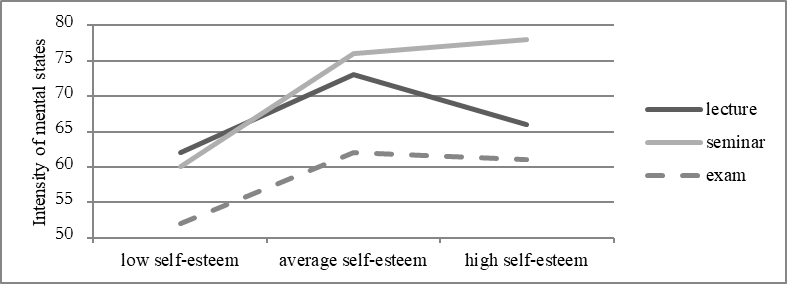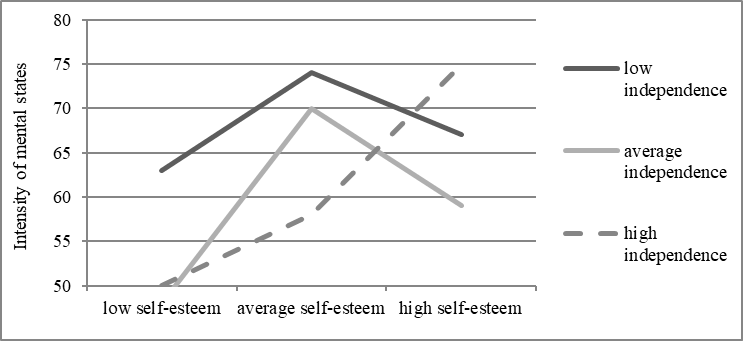Abstract
The article presents the results of a study of the influence of self-esteem on the mental states of students during educational activities. It is shown some foreign and Russian theoretical approaches concerning self-system. The study involved 69 students of the Institute of psychology and education aged 18-20 years. It is shown that there is a specificity of the self-esteem influence on psychological states depending on the forms of educational activity: at lectures, seminars and exams. It was established the mediating role of self-esteem in the self-regulation of students’ mental states. Students with low level of self-esteem at lectures and seminars are dominated by mental states of low intensity of manifestation. Students with an average level of self-esteem are characterized by positive states: from vigor and expectation to interest and gaiety. In the case of high self-esteem, mental states vary in modality and intensity. While the level of self-esteem increases, the intensity of manifestation of psychological states’ substructures (mental processes, experiences and behavior) also increases, and vice versa. The average self-esteem is most optimal in the regulation of mental states. In the case of high self-esteem, the most optimal psychological states are experienced by students with high independence. Students with low self-esteem experience the least intense states.
Keywords: Self-systemmental stateself-esteemself-regulationeducational activity
Introduction
In modern psychology, the mental mechanisms of regulation of human mental states are not properly investigated. This is especially true towards the "system of Self" and its role in the regulation of mental states. This situation is due to ,on the one hand, the lack of a developed conceptual framework that explains and describes the regulatory function of the “Self-system”, and, on the other hand, the unsettled categorical structure of the “system of Self”, which leads to vagueness in understanding the “Self” of a person.
The content and scope of this construct still remain controversial. In particular, when describing the “Self” of a person, his self-consciousness, different categories are used, as a rule, referring to a certain author’s theory: “identity”, “Self-concept”, “Self-image”, “Ego”, “empirical personality” , "Picture of Me" and others. In recent years, a significant number of studies of the "system of the Self" and related phenomena have been performed. Dozens of forms of "Self" were discovered: self-esteem, self-affirmation, self-control, verification of “Self”, “Self-discrepancies”, identity, etc. This is a very short and incomplete list of the huge variety of forms of “Self” discovered by psychologists (Leary & Tangney, 2003). However, a single area of research “Self” did not arise; rather, on the contrary, aggregation of a multitude of distinct regions arbitrarily assigned to the “Self” occurred (Baumeister & Bushman, 1998).
Problem Statement
At the same time, most researchers recognize the multidimensionality, hierarchy of the "system of Self" and include a wide range of forms of representations in it: self-image, emotional-value relationship, self-esteem, etc. The necessity of an integrative approach to the phenomenon of "Self" in order to disclose it as a coherent organized system is emphasized. In most studies, the “Self” is considered as the existential core of the personality, ensuring its internal self-organization and self-regulation.
The “Image of Self” is studied as an integrative institution, which includes a cognitive component: the image of one’s qualities, abilities, capabilities, social significance, appearance, etc.; affective - attitude to oneself (self-esteem, self-respect, self-humiliation, etc.), behavioral - the practical implementation of motives, goals in relevant behavioral acts (Dorfman, 2019).
In studying the influence of the “Self-system” on various manifestations of life and human behavior, a number of patterns were revealed. Therefore, Bandura (1978) showed that the “Self-system” includes cognitive structures and subfunctions for the perception, assessment and regulation of behavior. Another study identified differences in current and future perceptions of oneself (Liberman et al., 2007). Relationships of the “Self of the image” with the structure of self-esteem and self-acceptance (Kruczek, 2017), as well as the “Self of the image” with positive behavior (Venhoeven et al., 2013) were discovered. The role of self-esteem “Self” in perfectionism is shown (Nepon et al., 2011). Connections have been found between the aggression of “difficult” adolescents and the rigidity of their self-awareness system (Edens, 1999).
Research Questions
To a lesser extent, the relationship between the "system of self" and mental states is investigated. They are mainly concentrated in the field of medicine: the role of the “Self-system” in integrated counseling (Cook-Greuter & Soulen, 2007), in the treatment of depression (Strauman & Eddington, 2017), in self-organization strategies for psychotherapy (Rosa-Gonçalves et al., 2018).
Overall, the role of the "system of Self" in the mental regulation of states has been little studied. This situation is due to the lack of a developed conceptual framework explaining and describing the mental mechanisms of self-regulation of states, as well as the lack of empirical data.
Purpose of the Study
The main purpose of the study is to diagnose the effects of self-esteem level on the regulation of students’ mental states.
Research Methods
The study of self-esteem role in the regulation of mental states was attended by 69 first and second year students of the full-time department of the Institute of Psychology and Education, Kazan Federal University. The study of mental states was carried out in various situations of educational activity: at lectures, seminars and exams. During the study, the following methods were used:
Questionnaire "Relief of mental states of personality" (A.O. Prokhorov).
The method for the self-esteem study (M. Budassi).
The method "The style of behavior self-regulation" (V.I. Morosanova, E.M. Konoz).
It was used standard Mathematical Analysis Package SPSS 18.0. For the analysis of the research results used Spearman's correlation coefficient, short statistics and analysis of variance (ANOVA).
Findings
As a result of the studies, it was found that during various forms of educational activity, students with different levels of self-esteem are dominated by mental states of different intensity and modality. As shown in Table
Students with an average level of self-esteem are characterized by positive states of a high level of intensity: from cheerfulness and expectation to interest and gaiety. Mental states of students with high self-esteem vary in modality and intensity, with some prevalence of low-intensity states, such as drowsiness and fatigue. In a tense situation of exam, excitement is the dominant state for all levels of self-esteem. Students with an average level of self-esteem also have a state of concentration, while students with high self-esteem also experience fun state. Thus, it can be summarized that the average level of self-esteem is the most optimal for effective educational activities of students, since it is accompanied by an experience of positive mental states, including cognitive ones. Figure

As shown in picture 1, the least intense mental states are presented in the exam, regardless of the student’s self-esteem. Significantly more intense states are presented at lectures and seminars. Moreover, at seminars, the intensity of mental states reaches maximum values, especially of students with a high and medium self-esteem. In all forms of educational activity, the least intense mental states are observed in students with low self-esteem, however, as self-esteem increases from low to medium level, the intensity of students' experiences increases. The most interesting patterns were found in students with high self-esteem: at the exam and seminar, the intensity of states corresponds to the states of people with average self-esteem, while at the lecture it decreases significantly.
Most likely, people with low self-esteem are the least effective in all forms of educational activity, because they experience mental states of low energy activity. This is especially true of the exam situation, where the mental states of students with average and high self-esteem are more balanced. In the seminar form of educational activity, positive states of high and medium intensity were found in individuals with medium and high self-esteem. Note that, for students with an average self-esteem the most optimal is the lecture form of education.
Consider the relationship of self-esteem with various substructures of mental states. As shown in table
Next, we consider the mediating role of self-esteem in the regulation of students’ mental states during educational activities. As a result of ANOVA, it was found that the greatest influence on the interaction of mental states and self-esteem have the regulatory properties of “independence” (p <0,033) (Fig. 2, Table
As shown in Table

As shown in figure
Conclusion
Thus, as a result of the study, the following patterns were established:
Students with low level of self-esteem at lectures and seminars are dominated by mental states of low intensity of manifestation. Students with an average level of self-esteem are characterized by positive states: from vigour and expectation to interest and gaiety. In the case of high self-esteem, mental states vary in modality and intensity.
While the level of self-esteem increases, the intensity of manifestation of psychological states’ substructures (mental processes, experiences and behaviour) also increases, and vice versa.
The average self-esteem is most optimal in the regulation of mental states. In the case of high self-esteem, the most optimal psychological states are experienced by students with high independence. Students with low self-esteem experience the least intense states.
In applied terms, the obtained results are significant for practical purposes as the basis for the development of technologies, techniques, trainings in psychological counseling related to human life: social and psychological well-being, for the prevention and improvement of mental health, quality of life, the effectiveness of human activities.
Acknowledgments
The research was carried out with the financial support of the RFBR; project No. 20-013-00076;
References
- Bandura, A. (1978). The self-system in reciprocal determinism. American Psychologist, 33, 344-358.
- Baumeister, R. F., & Bushman, B.J. (1998). Threatened egotism, narcissism, self-esteem, and direct and displaced aggression: Does self-love or self-hate lead to violence? Journal of personality and social psychology, 75(1), 219-229.
- Cook-Greuter, S., & Soulen, J. (2007). The developmental perspective in integral counseling. Counseling and values, 51(3), 180-192.
- Dorfman, L. (2019). Metodologicheskiye osnovy empiricheskoy psikhologii. [Methodological foundations of empirical psychology]. Yurait Publishing House.
- Edens, J. F. (1999). Aggressive children's self-systems and the quality of their relationships with significant others. Aggression and violent behavior, 4, 151-177.
- Leary, M. R., & Tangney, J. P. (Eds.). (2003). Handbook of self and identity. Guilford Press.
- Kruczek, А. (2017). Relationship of self-image and self-acceptance with the expression of anger in girls diagnosed with conduct disorder. Psychiatria i Psychologia Kliniczna, 17(4), 314-324.
- Liberman, N., Trope, Y., & Wakslak, C. (2007). Construal Level Theory and Consumer Behavior. Journal of consumer psychology, 17(2), 113-117.
- Nepon, T., Flett, G. L., Hewitt, P. L., & Molnar, D. S. (2011). Perfectionism, negative social feedback, and interpersonal rumination in depression and social anxiety. Canadian Journal of Behavioral Science, 43(4), 297-308.
- Rosa-Gonçalves, D., Bernardes, M., & Costa, L. (2018). Quality of life and functional capacity in patients with rheumatoid arthritis–Cross-sectional study. Reumatología Clínica, 14(6), 360-366.
- Strauman, T. J., & Eddington, K. M. (2017). Treatment of Depression from a Self-Regulation Perspective: Basic Concepts and Applied Strategies in Self-System Therapy. Cognitive Therapy and Research, 41, 1-15.
- Venhoeven, L. A., Bolderdijk, J. W., & Steg, L. (2013). Explaining the paradox: how pro-environmental behavior can both thwart and foster well-being. Sustainability, 5, 1372-1386.
Copyright information

This work is licensed under a Creative Commons Attribution-NonCommercial-NoDerivatives 4.0 International License.
About this article
Publication Date
15 November 2020
Article Doi
eBook ISBN
978-1-80296-093-8
Publisher
European Publisher
Volume
94
Print ISBN (optional)
-
Edition Number
1st Edition
Pages
1-890
Subjects
Psychology, personality, virtual, personality psychology, identity, virtual identity, digital space
Cite this article as:
Prokhorov, A. O., Chernov, A. V., & Yusupov, M. G. (2020). The Role Of Self-Esteem In The Regulation Of Students’ Mental States. In T. Martsinkovskaya, & V. Orestova (Eds.), Psychology of Personality: Real and Virtual Context, vol 94. European Proceedings of Social and Behavioural Sciences (pp. 629-635). European Publisher. https://doi.org/10.15405/epsbs.2020.11.02.77

